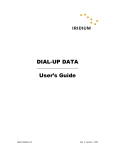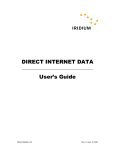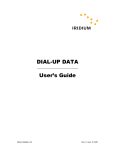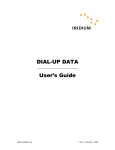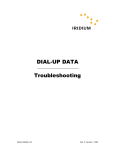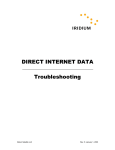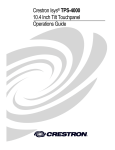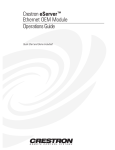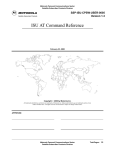Download Motorola 9520 User`s guide
Transcript
MOBILE-TERMINATED DATA User’s Guide Iridium Satellite LLC Rev. 4; January 1, 2003 MOBILE TERMINATED DATA ---------------------------------------------------------------------------------------------TABLE OF CONTENTS Revision History Revision Rev. 1 Rev. 2 Date Released November 15, 2001 February 1, 2002 Rev. 3 December 4, 2002 Rev. 4 January 1, 2003 Iridium Satellite LLC • • • • • • Description Initial document release. Removed geographic restrictions on mobile terminated data calls. Added revision history. Expanded section 1.2 to include all current MSISDN/MSISDN-C phone number combinations. Updated Hardware/Software Requirements. Updated Hardware/Software Requirements. 2 Rev. 4; January 1, 2003 MOBILE TERMINATED DATA ---------------------------------------------------------------------------------------------TABLE OF CONTENTS 1 Background................................................................................................................................ 4 1.1 IRIDIUM MOBILE TERMINATED DATA CONNECTIVITY ................................................................. 4 1.2 IRIDIUM PHONE NUMBERS ...................................................................................................... 5 2 Hardware/Software Requirements ............................................................................................ 6 3 AT Commands........................................................................................................................... 7 3.1 3.2 3.3 3.4 3.5 4 Mobile Terminated Call Scenarios............................................................................................. 9 4.1 4.2 4.3 4.4 5 BACKGROUND ....................................................................................................................... 7 USE OF AT COMMANDS WITH IRIDIUM PHONES ....................................................................... 7 ISU MODE OF OPERATION ..................................................................................................... 7 COMMAND ENTRY ................................................................................................................. 7 RESPONSES .......................................................................................................................... 8 BACKGROUND ....................................................................................................................... 9 CONFIGURE ORIGINATING ISU ............................................................................................... 9 CONFIGURE ORIGINATING PSTN PHONE .............................................................................. 10 CONFIGURE TERMINATING ISU ............................................................................................ 11 HyperTerminal Configurations................................................................................................. 12 5.1 ORIGINATING ISU................................................................................................................ 12 5.2 ORIGINATING PSTN PHONE ................................................................................................ 14 5.3 TERMINATING ISU ............................................................................................................... 17 6 Hardware Connections ............................................................................................................ 20 6.1 SETTING UP THE 9500 OR 9505 PORTABLE PHONE .............................................................. 20 6.2 SETTING UP THE PORTABLE DOCK, MOBILE PHONE, OR EUROCOM PHONE ........................... 21 7 Troubleshooting ....................................................................................................................... 22 8 Appendix A – Commonly used ISU AT Commands ................................................................ 24 Iridium Satellite LLC 3 Rev. 4; January 1, 2003 IRIDIUM MOBILE TERMINATED DATA ------------------------------------------------------------------------------------------------------------------- 1 Background Mobile Terminated Data refers to the ability to receive, or terminate, a data call on a computer connected to an Iridium phone. Mobile Terminated data calls can originate from a computer connected to another Iridium phone or from a computer connected to a phone on the Public Switched Telephone Network (PSTN). This service offers a typical data rate of 2.4 Kbps. 1.1 Iridium Mobile Terminated Data Connectivity Figures 1 and 2 illustrates the use of Iridium for mobile terminated data. The computer interfaces with the Iridium Subscriber Unit (ISU) via an RS-232 connection. The Iridium phone works in tandem with the Iridium constellation and gateway to operate as a “virtual modem.” Specifically, the ISU presents itself to the computer as an external modem and a modem in the Iridium Gateway provides the necessary functionality to interface with other modems via the PSTN. In this fashion, data connections can be supported from Mobile User to another Mobile User, Mobile User to a PSTN user (not shown in Figures 1 and 2), and PSTN user to Mobile user. Siemens D900 Iridium Gateway Figure 1. Iridium Mobile Terminated Data Connectivity: ISU to ISU Siemens D900 Modem PSTN Iridium Gateway Figure 2. Iridium Mobile Terminated Data Connectivity: PSTN to ISU Iridium Satellite LLC 4 Rev. 4; January 1, 2003 IRIDIUM MOBILE TERMINATED DATA ------------------------------------------------------------------------------------------------------------------- 1.2 Iridium Phone Numbers All Iridium data subscribers have two phone numbers, a “MSISDN” for voice calls, and a “MSISDN-C” for PSTN-to-ISU data calls. The following dialing rules apply: • • • When placing a voice call to an ISU, the caller must dial the MSISDN. When placing a PSTN-to-ISU data call, the caller must dial the MSISDN-C. When placing an ISU-to-ISU data call, the caller may dial either the MSISDN or the MSISDN-C. The following table shows the current Iridium numbering conventions: MSISDN (Voice Phone Number) starts with… 8816 214 8816 310 8816 314 8816 315 8816 317 8816 318 8816 762 8816 763 8816 766 Iridium Satellite LLC 5 MSISDN-C (Data Phone Number) starts with… 8816 931 8816 929 8816 929 8816 930 8816 932 8816 933 8816 764 8816 765 8816 767 Rev. 4; January 1, 2003 IRIDIUM MOBILE TERMINATED DATA ------------------------------------------------------------------------------------------------------------------- 2 Hardware/Software Requirements To use Mobile Terminated Data, you will need the following: A Computing Device with a serial port that is capable of transmitting AT commands to communicate with an external Hayes AT compatible modem. The computing device must conform to the ITU-T V.24 (RS-232) recommendation. A terminal emulation program, like HyperTerminal or Procomm. A SIM Card that is provisioned for data. An Iridium Phone with a data-capable internal software version and appropriate hardware: 1 2 3 4 Iridium Phone Type Software Version Required Hardware Required Motorola 9500 Portable Phone INC0620 or later1 Data Kit 1 Motorola 9505 Portable Phone LAC109G or later Data Kit Motorola 9520 Mobile Phone RAC0620 or later1 No Additional Hardware Required Motorola 9521 LBT-based products (e.g. the Iridium 9500 Data Module) RAC0620 or later Custom Cable and Power Supply2 Motorola 9522 LBT-based products All software versions for the 9522 are data capable Custom Cable and Power supply2 EuroCom Fixed Mount Unit Transceiver software version 3.xx.xx or later3 Serial Cable (included with the phone)4 To check the software version: Turn the phone on and press *#91#. Consult product documentation for details. Consult the user’s guide that came with the phone for instructions on how to check the transceiver software version. Included with the phone. Note that this is a “straight through” and not a null modem cable. Iridium Satellite LLC 6 Rev. 4; January 1, 2003 IRIDIUM MOBILE TERMINATED DATA ------------------------------------------------------------------------------------------------------------------- 3 AT Commands 3.1 Background In general, modems are controlled and configured through the use of AT commands. The AT command set was originally developed by Hayes Microcomputer Products. As a result, the set of generally applicable AT commands is known as the Hayes AT Command Set. Any modem that recognizes Hayes modem commands is said to be Hayes-compatible. The Hayes AT command set is the industry standard method of communicating with and setting up a modem. Virtually all modems manufactured today are Hayes-compatible. Likewise, virtually all communications software uses Hayes modem commands to interface with the modem. Notable examples include HyperTerminal, Procomm and Windows Dial-up Networking. 3.2 Use of AT Commands with Iridium Phones At the present time, all Iridium phones are Hayes compatible. In addition to the standard Hayes commands, additional command support is provided. The additional command support includes support for some AT commands specified for GSM handsets as well as some Iridium-specific commands. Since the Iridium phones are Hayes compatible, control and configuration is very much the same as for the vast majority of modems in use today. This also results in the ISU being interoperable with most commonly used communications software. 3.3 ISU Mode of Operation Like any Hayes compatible modem, the ISU is always in one of two modes, either command mode or data mode. When the ISU is in command mode (also known as off-line mode), AT commands can be entered to control the phone. When in data mode (also known as on-line mode), the ISU is connected to a remote system and any characters sent to it will be transmitted to the remote system. It is possible to enter the command mode without terminating the call by using the +++ escape sequence described in Appendix A. 3.4 Command Entry An AT command consists of a string of characters sent by the computer to the ISU while in command mode. A command string has a prefix, a body, and a terminator. The prefix consists of the ASCII characters AT or at. The body is a string of commands restricted to printable ASCII characters. The default terminator is the <CR> character (carriage return). The following rules apply to the entry of commands: 1. All commands (apart from A/ and +++) start with AT or at. The commands in a command string (apart from A/ and +++) are executed only after the return or enter key is pressed. 2. Use all upper or lower case letters, not a combination. 3. The maximum number of characters in a command string is 128. Multiple commands can be concatenated onto a single command line or by a semicolon. 4. Command editing can usually be performed by the backspace or delete keys. 5. If a parameter is missed from a basic command, a zero is implied (e.g. ATH implies ATH0). If an optional parameter is skipped from an extended command, the current value is implied. Optional parameters are enclosed by square brackets ([...]) in this document. 6. Spaces can be entered into a command string to increase clarity. These are ignored. 7. Characters that precede the AT prefix are ignored. 8. Ctrl-x can be used to abort a command line input. Iridium Satellite LLC 7 Rev. 4; January 1, 2003 IRIDIUM MOBILE TERMINATED DATA ------------------------------------------------------------------------------------------------------------------- The structure of an AT command is illustrated below: Figure 4. AT Command Structure 3.5 Responses A result code is sent to the computer in response to the execution of an AT command. In addition, a result code may also result from other events such as an incoming call. The ISU can be configured in either verbose or numeric mode. If in verbose mode, result codes are returned in the form of humanreadable text messages. If in numeric mode, result codes are returned in the form of numeric codes. By default, the ISU is in verbose mode. The ISU mode can be changed using the ATV command described in Appendix A. Some common results codes are presented in the following table. Verbose Code OK ERROR CONNECT NO CARRIER BUSY NO ANSWER RING Iridium Satellite LLC Numeric Code 0 4 1 3 7 8 2 8 Description Command executed Command rejected Connection established Connection terminated Busy signal detected No answer Incoming call received Rev. 4; January 1, 2003 IRIDIUM MOBILE TERMINATED DATA ------------------------------------------------------------------------------------------------------------------- 4 Mobile Terminated Call Scenarios 4.1 Background There are two basic Mobile Terminated call scenarios. In the first scenario, a mobile subscriber connects to another mobile subscriber. In the second, a user on the PSTN connects to a mobile subscriber. For both scenarios, the high level sequence of events is shown in Figure 4. As shown, there is an initial stage where each modem/ISU is configured using the command mode. The originating party then dials and a connection is established. When the connection is established, each modem/ISU enters the data mode and data is exchanged. Either party can initiate the call termination by first returning to the command mode and then entering the command to hang up. It should be noted that this sequence of events applies regardless of the communications software being used (e.g., HyperTerminal, Procomm, Dial-up Networking, etc.). The discussion that follows describes the AT commands that are used at each step in the sequence. Command Mode Originating Side Configure Modem/ISU Initiate Disconnect Dial Connection Established Terminating Side Configure ISU Command Mode Data Mode Data Exchange Wait for Call Disconnected Initiate Disconnect Figure 5. Mobile Terminated Call Sequence 4.2 Configure Originating ISU In your terminal emulation program, the serial port on the computer should be configured to support a rate of 19,200 bits per second,5 with 8 bit characters, no parity and one stop bit. Section 5.1 describes how to do this using HyperTerminal. The originating phone should be configured to request the appropriate Bearer Service using the following AT command: AT+CBST=6,0,1<carriage return>. 5 The Motorola 9500 baseline (which includes the Motorola 9520 and the EuroCom Fixed Mount Unit) requires that a fixed rate of 19,200 be used. All Iridium phones based on the Motorola 9505 will support “auto-bauding” wherein they can detect the baud rate up to a rate of 38,400 bits per second. It is recommended that 19,200 be used unless there is a specific requirement to do otherwise. Iridium Satellite LLC 9 Rev. 4; January 1, 2003 IRIDIUM MOBILE TERMINATED DATA ------------------------------------------------------------------------------------------------------------------- As with any Hayes compatible modem, the following AT command is used to dial the terminating ISU: ATDT<phone number><carriage return> where <phone number> is the data phone number (the “MSISDN-C”) of the terminating ISU. Since this is being dialed within the Iridium system, international dialing applies, so the number would be ‘00’ followed by the MSISDN-C of the terminating user (e.g., 008816929012324). After dialing has been initiated, a response code will be returned to indicate the disposition of the call (e.g., CONNECT, BUSY, NO ANSWER, NO CARRIER). Assuming a connection is established, both parties will enter the data mode and data exchange can occur. The sequence to initiate a disconnect is also like that used by any Hayes compatible modem. First, the following character sequence is sent to the ISU in order to cause it to return to the command mode: +++ Once the ISU has returned to the command mode, the following Hayes AT command is used to disconnect the call: ATH<carriage return> 4.3 Configure Originating PSTN Phone The need for configuration of the modem prior to dialing is a function of the specific modem being used. In general, this is not required. As with any Hayes compatible modem, the following AT command is used to dial the terminating ISU: ATDT <phone number><carriage return> where <phone number> is the data phone number (the “MSISDN-C”) of the terminating ISU. International dialing rules apply, so the phone number must be preceded by the international access code for the originating country. For example, in the United States, the number would be 011 followed by the MSISDN-C (e.g., 011881692901234). After dialing has been initiated, a response code will be returned to indicate the disposition of the call (e.g., CONNECT, BUSY, NO ANSWER, NO CARRIER). Assuming a connection is established, both parties will enter the data mode and data exchange can occur. The sequence to initiate a disconnect is also like that used by any Hayes compatible modem. First, the following character sequence is sent to the ISU in order to cause it to return to the command mode: +++ Once the ISU has returned to the command mode, the following Hayes AT command is used to disconnect the call: ATH<carriage return> Iridium Satellite LLC 10 Rev. 4; January 1, 2003 IRIDIUM MOBILE TERMINATED DATA ------------------------------------------------------------------------------------------------------------------- 4.4 Configure Terminating ISU In your terminal emulation program, the serial port on the computer should be configured to support a rate of 19,200 bits per second,6 with 8 bit characters, no parity and one stop bit. Section 5.3 describes how to do this using HyperTerminal. The terminating ISU must be configured to automatically answer when an incoming call is received.7 This is accomplished using the following standard Hayes AT command: ATS0=<N><carriage return> where <N> is an integer that corresponds to the number of rings that occur before the call is answered. In general, it is recommended to use a value of 1 for this (i.e. ATS0=1). When an incoming call is received, a RING response code is presented. Likewise a corresponding response code is received if the connection is successfully established (e.g., CONNECT). Assuming a connection is established, both parties will enter the data mode and data exchange can occur. The sequence to initiate a disconnect is also like that used by any Hayes compatible modem. First, the following character sequence is sent to the ISU in order to cause it to return to the command mode: +++ Once the ISU has returned to the command mode, the following Hayes AT command is used to disconnect the call: ATH<carriage return> 6 The Motorola 9500 baseline (which includes the Motorola 9520 and the EuroCom Fixed Mount Unit) requires that a fixed rate of 19,200 be used. All Iridium phones based on the Motorola 9505 will support “auto-bauding” wherein they can detect the baud rate up to a rate of 38,400 bits per second. It is recommended that 19,200 be used unless there is a specific requirement to do otherwise. 7 The Hayes AT command ATA can be used to manually answer an incoming call when it is received. This is not the recommended approach since it requires the user to be present and intervene when the call is received. Iridium Satellite LLC 11 Rev. 4; January 1, 2003 IRIDIUM MOBILE TERMINATED DATA ------------------------------------------------------------------------------------------------------------------- 5 HyperTerminal Configurations HyperTerminal is an example of a popular terminal emulation application. Such applications provide the user with a terminal interface to interact with and control a modem. In addition, they typically provide a basic mechanism to transfer data. HyperTerminal is part of all standard Microsoft Windows distributions. This section provides examples for configuring and using the HyperTerminal application for Iridium Mobile Terminated Data. Emphasis is placed on those items that are explicitly required or are unique to Iridium. Refer to HyperTerminal’s help facility for further details with regard to the more generic aspects of usage. 5.1 Originating ISU 1. When you first start the HyperTerminal application, you will be presented with the Connection Description window. Enter a name for the connection (“test” in the example shown below). Click OK. Iridium Satellite LLC 12 Rev. 4; January 1, 2003 IRIDIUM MOBILE TERMINATED DATA ------------------------------------------------------------------------------------------------------------------- 2. In the Connect using box, select the COMn or Direct to COMn option, where COMn designates the serial port used to communicate with the ISU (COM1 in the example shown below). Click OK. Note: Select the appropriate COM port. Do NOT select “Motorola Satellite Series Data Modem”! 3. Configure the port settings as shown below. Click OK. Iridium Satellite LLC 13 Rev. 4; January 1, 2003 IRIDIUM MOBILE TERMINATED DATA ------------------------------------------------------------------------------------------------------------------- 4. You will be presented with a terminal window, and AT commands can then be entered. In the example below, the user enters an initial command to verify that the interface is working, sets the bearer service, dials a remote ISU, connects, transfers data, and disconnects. (NOTE: The dialed number below is an example only. You must substitute your desired terminating ISU number) 5.2 Originating PSTN Phone 1. When you first start the HyperTerminal application, you will be presented with the Connection Description window. Enter a name for the connection (“test” in the example shown below). Click OK. Iridium Satellite LLC 14 Rev. 4; January 1, 2003 IRIDIUM MOBILE TERMINATED DATA ------------------------------------------------------------------------------------------------------------------- 2. In the Phone number box, enter the MSISDN-C of the ISU to be called. International dialing rules apply, so the phone number must be preceded by the international access code for the originating country. For example, in the United States, the number would be 011 followed by the MSISDN-C (e.g. 011 881692901234 as shown in the example below). In the Connect using box, select the modem you will be using to make the call. Click OK. 3. Click Modify. Iridium Satellite LLC 15 Rev. 4; January 1, 2003 IRIDIUM MOBILE TERMINATED DATA ------------------------------------------------------------------------------------------------------------------- 4. Make sure the Use country/region code and area code box is not checked. Click OK. 5. Click Dial. Iridium Satellite LLC 16 Rev. 4; January 1, 2003 IRIDIUM MOBILE TERMINATED DATA ------------------------------------------------------------------------------------------------------------------- 6. You will be presented with a terminal window and the modem will be in data mode as shown below. 5.3 Terminating ISU 1. When you first start the HyperTerminal application, you will be presented with the Connection Description window. Enter a name for the connection (“test” in the example shown below). Click OK. Iridium Satellite LLC 17 Rev. 4; January 1, 2003 IRIDIUM MOBILE TERMINATED DATA ------------------------------------------------------------------------------------------------------------------- 2. In the Connect using box, select the COMn or Direct to COMn option, where COMn designates the serial port used to communicate with the ISU (COM1 in the example shown below). Click OK. Note: Select the appropriate COM port. Do NOT select “Motorola Satellite Series Data Modem”! 3. Configure the port settings as shown below. Click OK. Iridium Satellite LLC 18 Rev. 4; January 1, 2003 IRIDIUM MOBILE TERMINATED DATA ------------------------------------------------------------------------------------------------------------------- 4. You will be presented with a terminal window. AT commands can be entered as shown below. You must configure the computer to answer using the ATS0 command as shown. Iridium Satellite LLC 19 Rev. 4; January 1, 2003 IRIDIUM MOBILE TERMINATED DATA ------------------------------------------------------------------------------------------------------------------- 6 Hardware Connections 6.1 Setting up the 9500 or 9505 Portable Phone 1. Insert a data-provisioned SIM card into the phone. (See the user guide for your phone if you need further instructions on how to insert the SIM card.) 2. Connect the Data Adapter to the bottom of the phone. (Optionally) connect a charging device to the Data Adapter. Plug the Serial Cable into the Data Adapter. 3. Plug the Serial Cable into the serial port on your computer. 4. Rotate and extend the phone’s antenna. Place the phone into the stand, or otherwise position the phone so that the antenna is vertical and has a clear view of the sky. Iridium Satellite LLC 20 Rev. 4; January 1, 2003 IRIDIUM MOBILE TERMINATED DATA ------------------------------------------------------------------------------------------------------------------- 6.2 Setting up the Portable Dock, Mobile Phone, or EuroCom Phone 1. Insert a data-provisioned SIM card into the phone. (See the user guide for your phone if you need further instructions on how to insert the SIM card.) 2. Plug a Serial Cable into the data port on the Portable Dock or EuroCom Phone (Note: The 9520 Phone has a built-in serial cable in the wiring harness.) 3. Plug the Serial Cable into the serial port on your computer. 4. Connect an external antenna, and orient the antenna so that it has a clear view of the sky. Iridium Satellite LLC 21 Rev. 4; January 1, 2003 IRIDIUM MOBILE TERMINATED DATA ------------------------------------------------------------------------------------------------------------------- 7 Troubleshooting Cannot register with the Iridium network • • • • • Is a SIM card inserted into the phone? Check to see that the antenna is fully attached, fully extended and vertical, and that there is clear lineof-site to the sky. Check antenna cable connections. Are they tight? Turn the phone off and then on again and wait for the phone to register. For Motorola phones only: If the phone will not register, attempt to force registration by pressing ↑ 8 on the phone’s keypad. Phone is registered, but cannot make a mobile-terminated data connection. General: • Verify that the phone is displaying good signal strength. • Is the SIM card provisioned for data? If in doubt, contact your Iridium Service Provider. • Is the software version in the phone data-capable? See Section 2 for instructions on how to check the software version. • Check the serial cable connections. Are they tight? • Is the terminating ISU set to auto answer? (using the ATS0=1 command). • If you type “AT” in your terminal emulation program, do you see the “OK” response? If not, check your terminal emulation settings, as described in Sections 4.2 and 4.4. PSTN to ISU: • Have you configured the terminating computer for 19,200 bits per second, 8 characters, no parity, 1 stop bit? • Was the number dialed in international format? (International Access Code + MSISDN-C of terminating ISU.) For example, the dialing pattern from a PSTN phone in the United States is 011 881692901234, where 011 is the international access code and 881692901234 is the MSISDN-C of the terminating ISU. • Check to make sure you are dialing the MSISDN-C (not the MSISDN) of the terminating ISU. • If the terminating ISU is a 9500, 9505 or 9520, it should display “Data Call In Progress” when it receives a data call using the MSISDN-C. If it displays “Answer?” instead of “Data Call In Progress”, and you are calling the MSISDN-C as described above, then the problem is most likely external to Iridium. • Is the problem external to Iridium? ⇒ Are you calling from a PBX? Some PBX’s will corrupt data transmissions. Try placing the call from another location, outside of the PBX. Iridium Satellite LLC 22 Rev. 4; January 1, 2003 IRIDIUM MOBILE TERMINATED DATA ------------------------------------------------------------------------------------------------------------------- ⇒ In many countries, the PSTN can corrupt data calls. PSTN calls originating in the Middle East, Southeast Asia, China, India, Russia and Taiwan are particularly subject to problems. The end-to-end data call quality and probability of connection is governed by the ability of modems at the Iridium gateway to synchronize with modems at the originating location. Modem synchronization is directly impacted by voice compression that is used by international telephony carriers. International telephony carriers typically compress the analog speech, and consequently modem tones, to reduce their bandwidth requirements for carrying calls. This compression can alter the modem tones resulting in reduced connection speeds, dropped connections, or no connections. ISU to ISU: • Have you configured the originating and terminating computers for 19,200 bits per second, 8 characters, no parity, 1 stop bit? • Have you configured the originating ISU for the correct bearer service (using the command AT+CBST=6,0,1)? • Was the number dialed in international format? When dialing from ISU to ISU, the dialing format is always 00 + MSISDN-C of terminating ISU. For example: 00 881692901234, where 881692901234 is the MSISDN-C of the terminating ISU. Iridium Satellite LLC 23 Rev. 4; January 1, 2003 IRIDIUM MOBILE TERMINATED DATA ------------------------------------------------------------------------------------------------------------------- 8 Appendix A – Commonly used ISU AT Commands AT – ATtention Code This is the prefix for all commands except A/ and +++. When entered on its own, the ISU will respond with the OK results code. A/ – Repeat Last Command Repeat the last command issued to the ISU unless the power was interrupted or the unit is reset. A/ is not followed by <CR>. +++ – Escape Sequence The escape sequence is used to transfer from data mode to command mode without disconnecting from the remote modem. After a pause, the ISU will respond with OK. Register S2 can be used to alter the escape character from +, the factory default, to any hexadecimal value in the range 0 to 255. A – Answer Answer immediately. This causes the ISU to answer the incoming call. D – Dial Dial a number. The dial command causes the ISU to enter originate mode and act as an auto dialer for connection to other modems. The usual format is ATDnx..x where n is a Dial Modifier and x is a number. The following are valid numbers: 0123456789*#ABC. Dial modifiers are used to alter the manner in which the ISU dials. L Redial last number. P Use pulse dialing (No action, compatibility only). T Use tone dialing. Any character received from the DTE during the call establishment phase will cause the call attempted to be terminated. Hn – Hangup Control the hook switch. This command is used to clear a connection. 0 Place the ISU on hook. +CBST – Select Bearer Service Type Set Command: +CBST=[<speed>[,<name>[,<ce>]]] Select the bearer service type for mobile originated calls. <speed> should have the following value: 6 4800 bps V.32 <name> takes the following value: 0 data circuit asynchronous <ce> can only take the following value: 1 non-transparent Read Command: +CBST? Iridium Satellite LLC 24 Rev. 4; January 1, 2003 IRIDIUM MOBILE TERMINATED DATA ------------------------------------------------------------------------------------------------------------------- Query the current bearer service type settings. Response is in the form: +CBST: <speed>,<name>,<ce> Test Command: +CBST=? List the supported <speed>, <name>, <ce>. Response is in the form: +CBST: (supported <speed>s),(supported <name>s),(supported <ce>s) S0=n – Auto Answer Assigning a value from 1 to 255 in register S0 tells the ISU to automatically answer incoming calls after n rings, where n is in the range 0-255. The recommended setting is ATS0=1, which sets the ISU to answer after one ring. The setting of 0 (ATS0=0) turns off the automatic answer feature. V – Verbose Mode Set the response format of the ISU, which may be either numeric or textual 0 Numeric responses 1 Textual responses (default) Iridium Satellite LLC 25 Rev. 4; January 1, 2003 IRIDIUM MOBILE TERMINATED DATA --------------------------------------------------------------------------------TRADEMARK NOTICE Trademark Notice Iridium and the Iridium logo are registered trademarks and/or service marks of Iridium Satellite LLC. Windows, Windows 95, Windows 98, Windows Me, Windows NT, Windows 2000, Windows XP, Dial-Up Networking, Outlook, Outlook Express and Internet Explorer are registered trademarks of Microsoft Corporation. HyperTerminal is a registered trademark of Hilgraeve, Inc. Procomm is a registered trademark of Symantec, Inc. Motorola and Satellite Series are registered trademarks of Motorola, Inc. Iridium Satellite LLC 26 Rev. 4; January 1, 2003



























